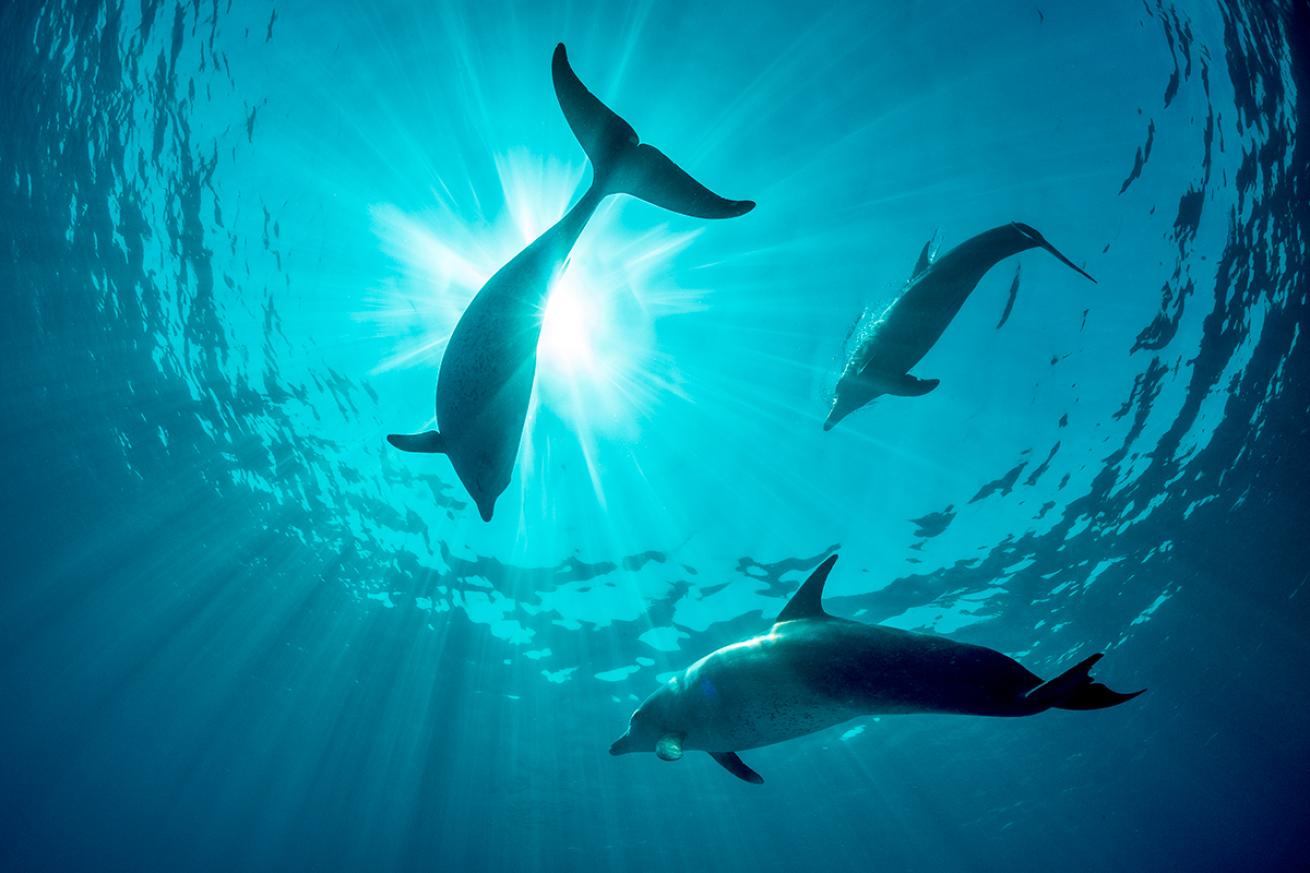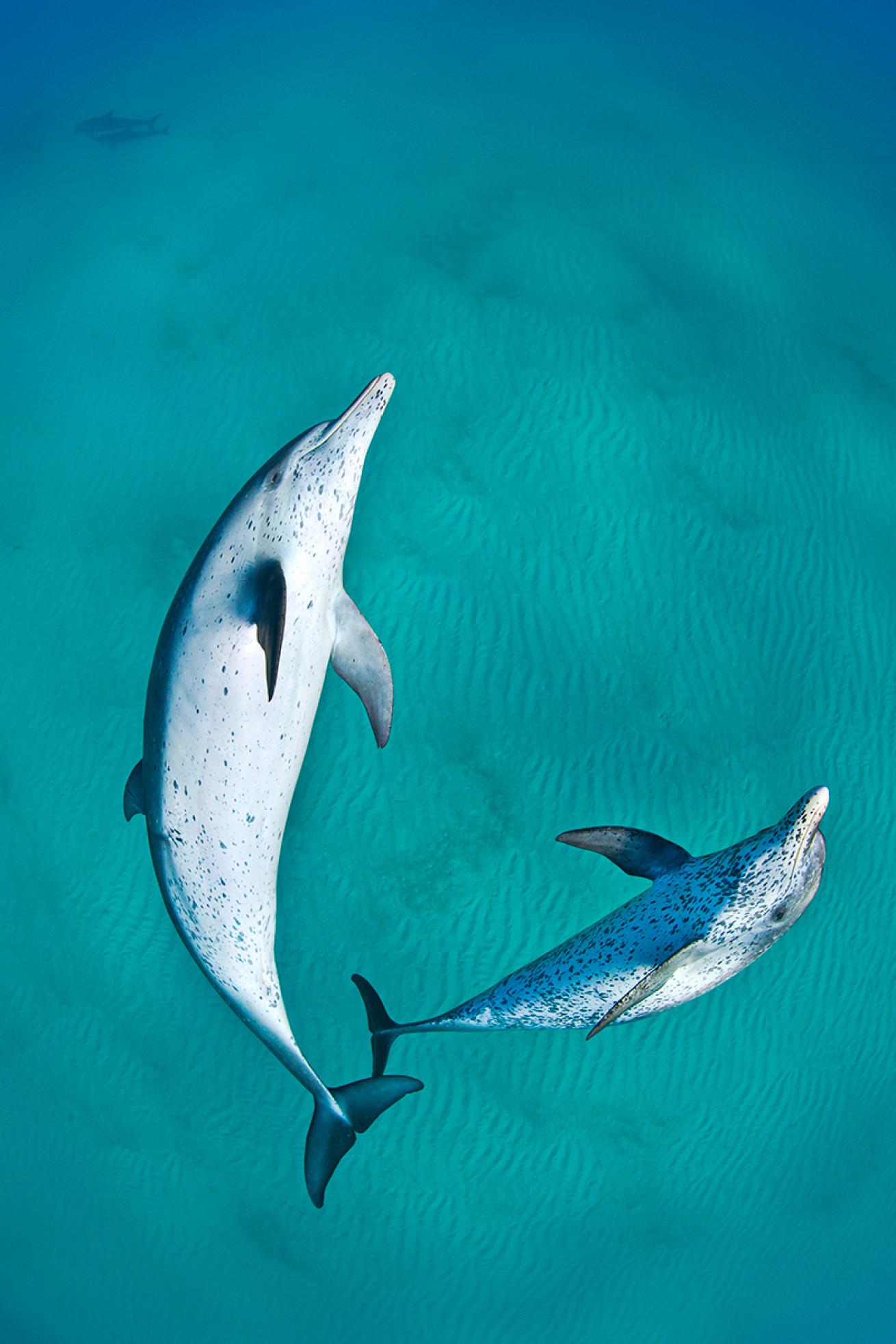How to Take Great Dolphin Photos

Alex MustardYou will want to be unencumbered with strobes and strobe arms when you have an encounter like this one with bottlenose dolphins in the Red Sea.
Dolphin photos are the ultimate crowd-pleaser. Does any subject impress our nondiving friends more? And is any subject less cooperative?
Dolphins usually turn up when we’re not expecting them. Even when we set out for encounters, they never stay still and pose. For me, the most important rule is: Get in and try. Often we get nothing, but other, unforgettable times, we get long-lasting interactive encounters.
Just about any dolphin pic will get oohs and aahs from friends, but producing a shot that captures the grace and athleticism of the subject during such ephemeral and unpredictable encounters takes the right preparation. Especially because when dolphins do appear, you’re unlikely to be focused on camera settings.
TIP 1: Light Speeds
All dolphin photos look good on the back of the camera, but time and again photographers are disappointed when they download and details are not sharp. Dolphins move very quickly, and the shots—usually taken without strobes—are slightly blurred. If you take nothing else from this article, remember that when you see dolphins, get your shutter speed up. Push the ISO and open the aperture if you need to, but a shutter speed of at least 1/250—better 1/500 or more—will keep their features sharp.
Photographers don’t usually use flash with dolphins. They don’t often come close enough, and they don’t have any pretty colors worth illuminating. Perhaps most critical when shooting them is a compact camera rig. Strobes and strobe arms are a drag when swimming or panning after fast-moving dolphins. So even when the encounter isn’t expected, such as after a dive, I always whip off my strobes and arms before jumping back in.
Without flash, exposures are easy with dolphins—they will be the same as the water, meaning you can set up before the dolphins come into view. I often use the Auto ISO function, available on most cameras. Auto ISO allows you to dial in your choice of (fast) shutter speed and (slightly open) aperture, and then the camera adjusts the ISO to create the correct exposure. I simply set 0.7 or 2⁄3 stop of underexposure to create a rich water color. If your camera does not have Auto ISO, use Shutter Priority auto exposure so you can set a fast shutter speed and the camera will vary the aperture to give the correct exposure.
I also engage the camera’s motor drive so I can get multiple frames of the best pass; it’s a feature rarely used underwater because of the need to wait for strobes to recycle. If your camera gives you a choice, three to five frames per second is ideal. Autofocus is very reliable with dolphins, so I just use standard wide-angle settings.
TIP 2: Brain Power
The right preparation means you’re ready to shoot quality images; now you just need to catch the dolphins in the right mood. There is definitely a direct correlation between the quality of the encounter and the quality of the shots. Local knowledge, or “field craft,” as wildlife photographers call it, is invaluable for getting lasting encounters with dolphins. Dolphins are intelligent animals with complex daily routines. For example, in the Bahamas, Atlantic spotted dolphins tend to feed in the Gulf Stream at night—in the mornings they are resting and not in the mood for encounters. By mid-afternoon—known as dolphin happy hour by local operators— they’re ready to play. In the Red Sea, by contrast, spinner dolphins in Fury Shoal are most playful mid-morning, while bottlenoses farther north seem to be in the mood for encounters in the late afternoon. Work with local experts for the best chance of catching prime time.

Alex MustardSpotted dolphins at Sandy Ridge, Little Bahama Bank; get a sharp shot of these quick-moving creatures by using a fast shutter speed.
One of the first lessons we learn as underwater photographers is the slower we move, the better our photos. A slow diver sees more subjects, disturbs less sediment and can maneuver close to a subject. Forget all that with dolphins. Dolphins have such mastery of the underwater world that, to them, we seem stuck in a slow-motion replay. Standard practice is to watch which direction the pod is moving and get ahead of it in a boat. Dolphins are definitely more interested in swimmers who move quickly, diving down, twisting and somersaulting in the water. The more you pique their curiosity, the more likely you will get close passes. If you have the option, wear bright colors and make noises—your buddies will soon stop laughing when they see your photos.
Above all, remember to look beyond the camera. Swimming with wild dolphins is an experience to treasure, especially when they come right to you. If you’re well-prepared, there will be time to record both images and memories.










